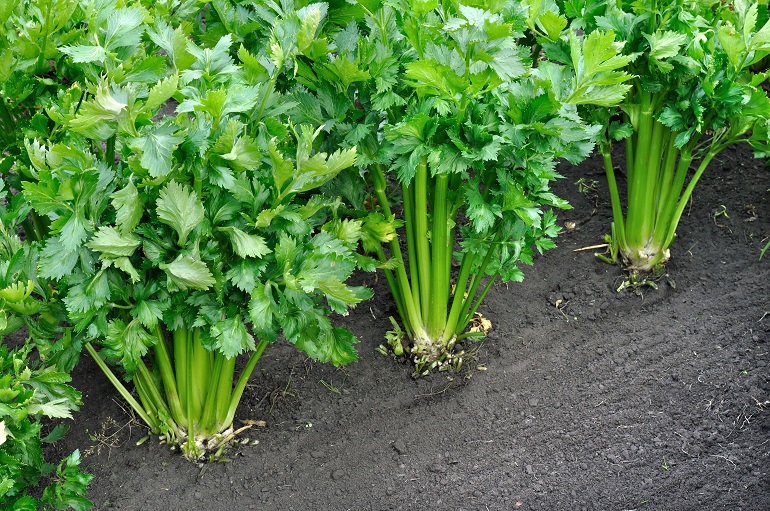Celery Fertilizer Requirements

This post is also available in:
This post is also available in:
![]() Deutsch (German)
Deutsch (German) ![]() हिन्दी (Hindi)
हिन्दी (Hindi) ![]() Ελληνικά (Greek)
Ελληνικά (Greek)
Note: the following information is for Apium graveolens var. graveolens (Celery).
To plan the fertilization schedule with higher precision and reduce the losses of nutrients due to runoff or nutrient toxicities caused by nutrient surplus, each farmer is advised to start by performing a soil analysis in his/her field. No two fields are the same, nor can anyone advise you on fertilization methods without taking into account your soil’s test data, tissue analysis, and crop history of your field. However, below you can find some of the most common celery fertilization schemes many farmers use.
Celery is a heavy eater and is considered the most nutrient-demanding among the cool-season vegetables. In general, for the production of 50-60 tonnes of celery per hectare (20-24 t/acre), 150 kg (134 lb/acre) N, 50 kg (45 lb/acre) P, and 350 kg (312 lb/acre) K are removed from the soil. Among the 3 primary nutrients, nitrogen (N) needs to be handled with the most caution because of the high risk of runoff. More specifically, no application should be performed before winter and heavy rains. Small quantities of N fertilizers can be applied before transplanting the celery seedling to the ground to boost their vegetative growth. Generally, 20-30 lb per acre (22-34 kg/ha) can be used. If celery succeeds a legume crop, the amount of nitrogen used in pre-planting can be decreased. In fields where a drip irrigation system is used, farmers can apply the rest of the fertilizers (top dressed) needed during the growing season with fertigation. It is essential to know that the celery’s needs for N constantly increase as the plant grows and peaks 2 weeks before harvest. To cover these needs, it is advised to increase the weekly N fertilization from 15-20 lb per acre (17-23 kg/ha), during the 8th week before harvest, to 35 lb per acre (39 kg/ha), 2 weeks before harvest. These applications should keep the (top) soil nitrate levels above 20 ppm for good plant growth. However, overfertilization with nitrogen should always be avoided, especially in plantations suffered by the black heart, since it can aggravate the symptoms.
The celery grower may need to apply phosphorus (P) to the field when the soil analysis shows that the level of bicarbonate-extractable phosphorus is below 60 ppm. In this case, a pre-planting application (broadcasted or band placed) of 40-80 lb per acre (45-90 kg/ha) of P2O5 is recommended. On the other hand, in soils with high P concentration, farmers are advised to apply zinc (Zn) fertilization as well. Similarly, the acceptable limit for potassium (K) is above 150 ppm, and it is essential to compensate for the amounts of the nutrient lost by harvest to maintain soil fertility.
Suppose the celery farmer wants to use granular fertilizers for direct soil application. In that case, he/she can apply the entire amount of P2O5 and K2O, together with 1/3 of N one week before planting (to boost root and vegetative growth), and continue by dividing the rest of N into 3 more applications during the growing period. The split application of N decreases the risk of nutrient leaching and increases rapid head development. In organic farming, many producers add 40-100 tonnes per hectare (16-40 t/acre) of well-digested manure to cover the nitrogen needs of celeries. In organic celery farming, producers use only approved fertilizers for organic farming (ask an agronomist).
In some cases, except for the basic 3 nutrients (N, P, K), celery may need complementary nutrition with Ca, B (1-2 lb per acre or 1.3-2.3 kg per hectare), and Mg (0.5-1.0 lb/acre or 0.56-1.12 kg per hectare). Deficiencies of these nutrients may result in black heart disease, fragile stem, and chlorosis, respectively. Ca deficiency may appear during accelerated plant growth, moisture stress, and high temperatures. To treat it, you can spray 10 lb calcium chloride or 15 lb calcium nitrate per acre, or 11.2 and 17 kg per hectare, respectively.
Crop growth regulators, like Gibberellic acid (GA), can be used in some cases. Learn more about this practice here.
References
- https://anrcatalog.ucanr.edu/pdf/7220.pdf
- http://nhb.gov.in/model-project-reports/Horticulture%20Crops/Celery/Celery1.htm
- https://www.gov.nl.ca/ffa/files/agrifoods-plants-pdf-celery.pdf
- https://www.dalrrd.gov.za/Portals/0/Brochures%20and%20Production%20guidelines/Brochure%20Celery.pdf
- https://horticulture.oregonstate.edu/oregon-vegetables/celery-2
Further reading
Interesting Facts, Nutritional Value and Plant Information of Celery
How to Grow Celery in a Pot in your garden
Growing Celery for Profit – Commercial Celery Farming
Celery Soil preparation, Soil requirements, and Seeding requirements
Celery Water Requirements – How to irrigate Celery
Celery Fertilizer Requirements









































































